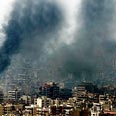Annie
Diamond Member
- Nov 22, 2003
- 50,848
- 4,828
- 1,790
I'm sure Dmp, Mr. B, and others can comment:

http://littlegreenfootballs.com/weblog/?entry=21956_Reuters_Doctoring_Photos_from_Beirut&only

http://littlegreenfootballs.com/weblog/?entry=21956_Reuters_Doctoring_Photos_from_Beirut&only
Saturday, August 05, 2006
Reuters Doctoring Photos from Beirut?
OK, now things are getting weird.
This Reuters photograph shows blatant evidence of manipulation. Notice the repeating patterns in the smoke; this is almost certainly caused by using the Photoshop clone tool to add more smoke to the image. (Hat tip: Mike.)
Its so incredibly obvious, it reminds me of the faked CBS memos. Smoke simply does not contain repeating symmetrical patterns like this, and you can see the repetition in both plumes of smoke. Theres really no question about it.
Smoke billows from burning buildings destroyed during an overnight Israeli air raid on Beiruts suburbs August 5, 2006. Many buildings were flattened during the attack. REUTERS/Adnan Hajj
3:41 PM PDT



